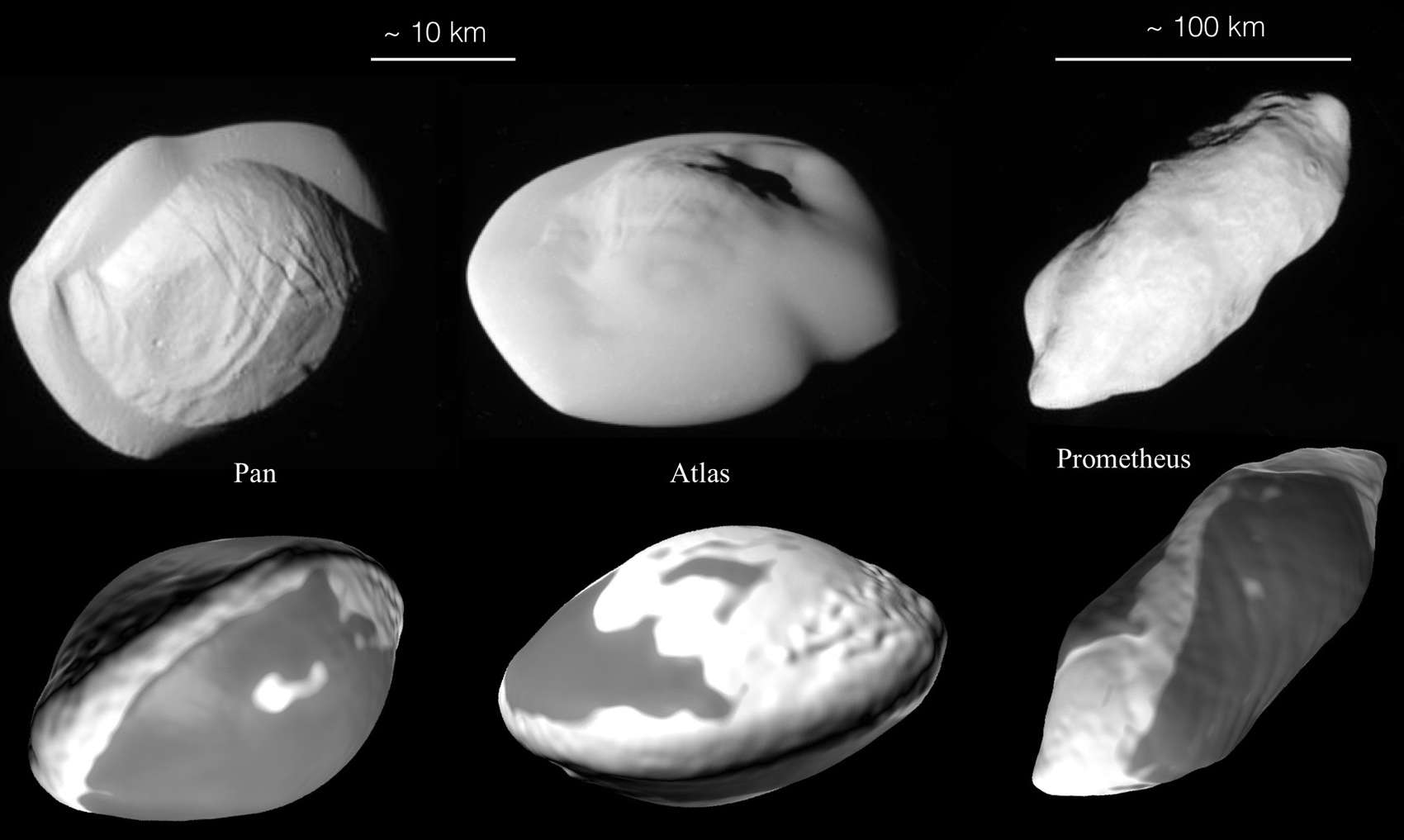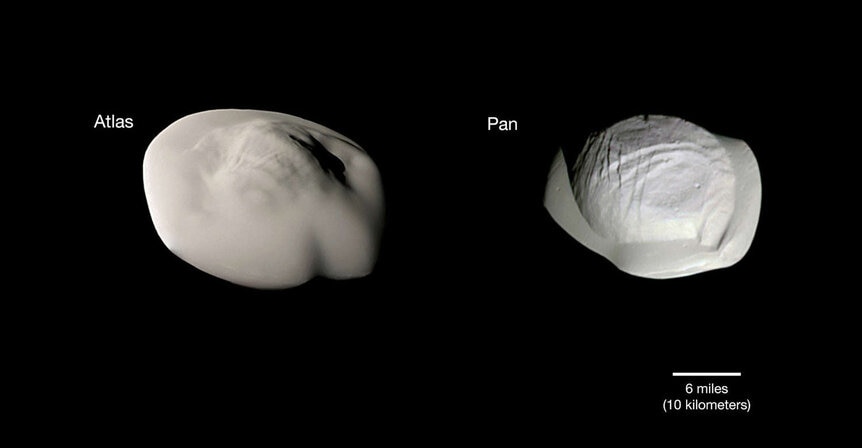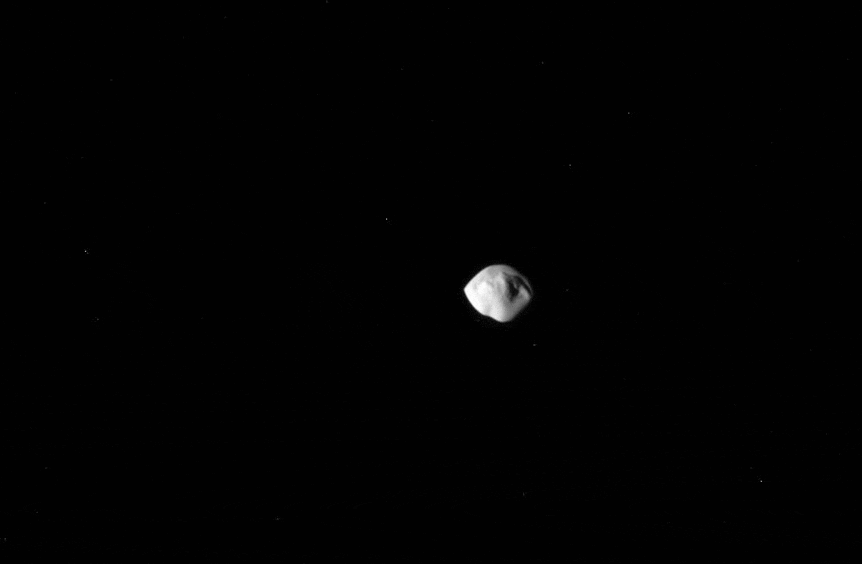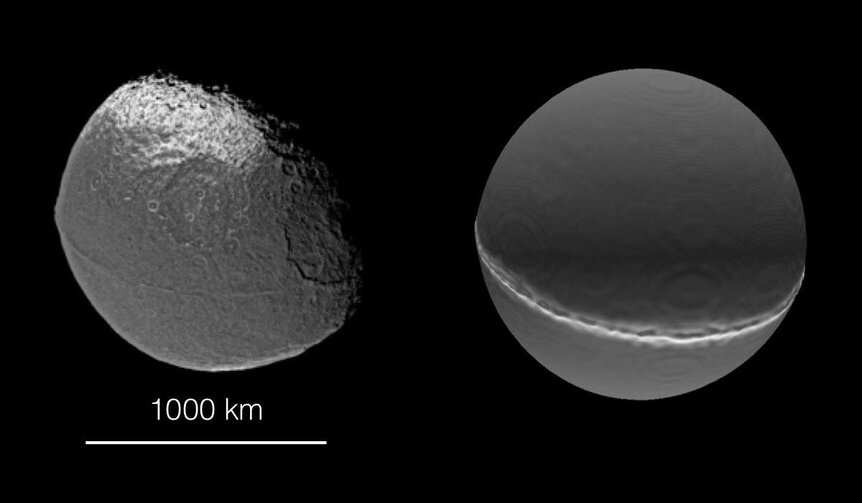Create a free profile to get unlimited access to exclusive videos, sweepstakes, and more!
Explaining Saturn's ravioli moons

Saturn's moons are weird.
I mean, really weird. When the Cassini spacecraft showed up at Saturn in 2004 and started doing flybys of some of the inner moons, the images it sent to Earth were so bizarre I actually had to look at them for a moment to even understand the shape I was seeing.
That's because some of them look like, well... ravioli. Yes, seriously.
That image shows the small (~35 kilometer wide) moons Atlas and Pan. I mean, come on. Just looking at them makes me hungry.
What could cause them to have these wide rims?
The first thought had to do with location. Both moons orbit Saturn in or very near the ring system. The broad outer ring of Saturn is called the A ring, and it has a gap in it called the Encke Gap, which is about 325 km wide. Pan orbits inside this gap, and Atlas just outside the sharp outer edge of the A ring. If the gravity of the moons could attract the icy ring particles to them, they could accumulate along the moons' equators, and in the moons' weak gravity form these bizarre structures.
If this were the case, though, the moons should form ellipsoidal shapes (like a rugby ball) due to the tides from Saturn's gravity. They don't, so something else must be going on.
A team of planetary scientists came up with another idea that could explain these shapes: Slow speed collisions.
In this scenario, the moons do grow by small particles colliding and sticking together, but the process changes with time, as bigger objects form. First, a decently sized moonlet forms in the outer rings and, due to interactions with the rings, moves out from Saturn. A second, smaller moon then forms in the spot where the first one formed, and it too moves out. This process continues, with each moon growing as it moves through and away from the rings, and you wind up with a series of moons that get bigger the farther out from Saturn they are; this growth process is called the pyramidal regime.
But what happens after? The new work looks at slow speed collisions between these moons, to see what shapes they take on. Using sophisticated computer models of how objects like these behave when they collide, they found an astonishing thing: When they accounted for the objects' mass, texture (they tend to be porous as opposed to solid), and the tides from gravity, they were able to reproduce the shapes of Pan and Atlas pretty well.
The collisions have to be head-on, or nearly so, and occur at speeds of some dozens of meters per second (roughly up to twice as fast as highway speeds). When that happens, the two collide, merge, and kinda sploosh together like slushballs, forming a ridge around them as the material gets squished out (like the ice cream part of an ice cream sandwich if the ice cream is too warm, and these food analogies are killing me)
After the moonlet with a ridge forms, debris from the impact that was thrown into space around it can re-accumulate, forming the broader ravioli-type rims. It might also be possible some of that material comes from the rings as well, like the first idea posited.
This method even explains the very odd shape of the moon Prometheus, which is elongated and has pointy tips at its ends. If the collision were not precisely head-on, but off by a few degrees, the off-center impact causes the resulting object to be more elongated, and the tides from Saturn stretch it further, creating the twisted, pointed shape. Their models match the actual shape of the moon eerily well.
Head-on collisions would be a natural outcome of the pyramidal process, since the moons form initially in the plane of the rings, which is very tightly constricted. So that part works as well.
While they find this method works for inner moons, it could work for some large outer moons as well. I recently wrote about Iapetus, an outer moon of Saturn that's 1,500 km wide, and has a huge ridge that runs all the way around its equator. In that article I wrote about some research that showed how a ring of material around the moon after a collision might have accumulated on the surface, piling up to form the continuous mountain range.
But this new work suggests the ridge formed after a slow speed collision between two moons each with half of the mass of Iapetus. That's possible, but a head-on collision is less likely as far out as Iapetus orbits (well over 3 million km from the planet) and at a significant orbital tilt of 15° to Saturn's equator. Perhaps Iapetus formed the way they predict and the something happened to put it at a highly inclined orbit. It's not clear.
The lessons of this tale are many. One is that it's possible to explain the weird shapes of Saturn's inner moons, and maybe some others too, but the exact details can be difficult to pin down. Another is that competing theories are good, since sometimes parts of them are correct and can be combined.
A third is that, even now, years after Cassini finished its mission and plunged into Saturn's atmosphere, we still don't truly understand what's going on with the ringed world's fleet of strange, strange moons. It may take a while before this all comes together, and perhaps by then we'll have another mission at Saturn that can negate or support these ideas.
Saturn is a beautiful and weird place. I expect there will always be questions about it still to answer.






























